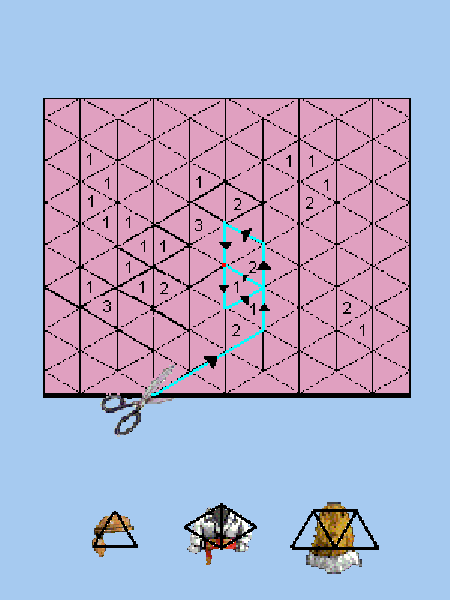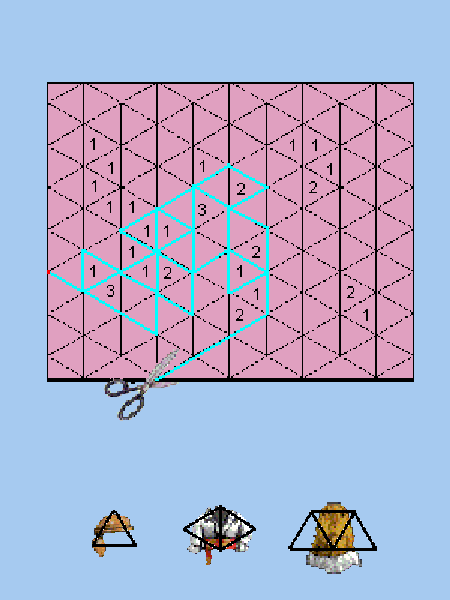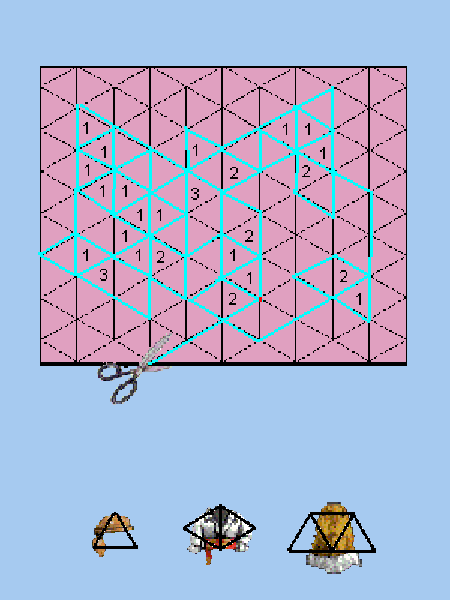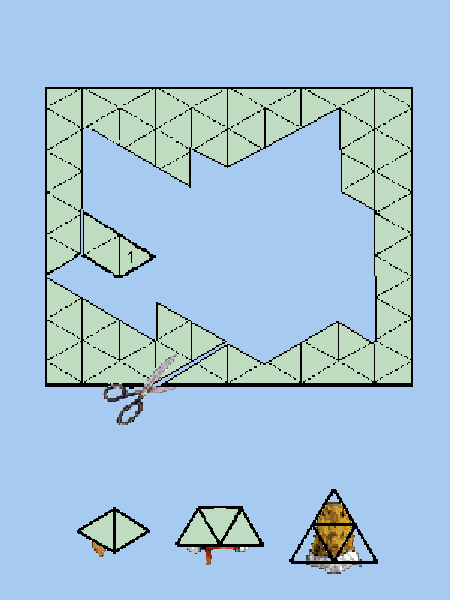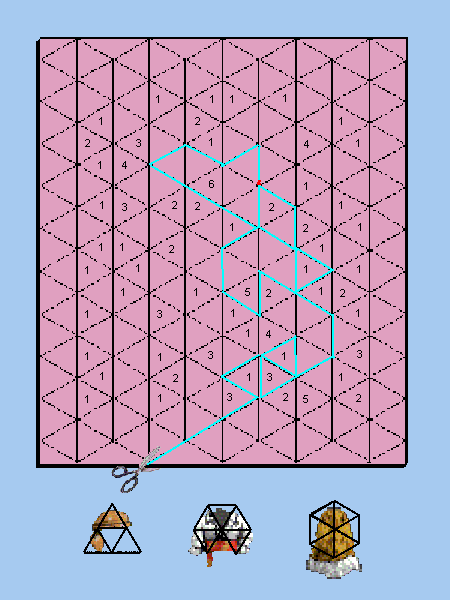GCPP:Proposal-Tiddler
Puzzle Codename: Tiddler
| Contact | |
| Username: | deathprog23 |
| Additional contact info: | Oneiropoios on Midnight, Hooke on Viridian, p.j.howard@rhul.ac.uk |
| Project forum thread: | Tiddler's forum thread |
Game concept
Cut out pieces of cloth, matching the size of the piece to the number on it.
Objective
Primarily, to cut out as many pieces as possible using the fewest cuts possible. Additionally to make specific shapes for bonuses.
Gameplay
A board is generated as shown below (see images section for full board), representing a large piece of cloth. The idea is to separate out the different numbers by cutting around them with the pair of scissors. Matching the number of triangles in a cutout to the number on it scores points. Players are otherwise free to make the shapes in whatever form fits best.
One starts by clicking at an edge point to start a cut. Then one left clicks at a sequence of nodes, all linked by straight lines with no repetition. This causes the shimmering blue line seen below to highlight the proposed cut. Clicking on the last node visited (indicated by a flashing red dot) returns the preview to the previous point and this can be repeated so the whole path can be changed. When the player is satisfied with the path, right clicking sends the scissors whizzing around and any cut out pieces are put aside and scored.
This process repeats until all the numbers are removed.
Making one of the shapes indicated by the clothes at the bottom (a hat, a top and a skirt) fills in that section. Once all three are filled, the cloth colour changes and one starts again (with the number grid left unchanged).
Storyboard: A starter Tiddler game
Looking at the clothes at the bottom, I saw that to reach the next cloth level I need to make 1, 2 and 3 piece cutouts. Knowing how the game works I decide to try and make as big a combo as I can to flex my scissor muscles. Dragging the mouse around moves the scissors. When they reach what looks a sensible point on the boundary I click and a red dot appears at that point. The cursor changes to an aqua dot with a line extending between the dots.
I move the cursor up to pass the 2 and left click at its right hand corner. The red dot moves to that point and the aqua line between them is fixed in place. A quick series of four clicks wraps the line up and around that 1 piece I need to fill the bandana. (In this first screen shot I have added arrows to the aqua lines for clarity of the moves.) I then follow this up with another three clicks to take me around the second piece I need, the adjacent 2 piece, and pause to survey the situation.
Not content with this fine start, I then quickly extend my proposed combo. Next finished is the 3 piece I need to finish the first set of clothes. I could stop at this point, but I know that the cloth can change mid combo - and that the next set will need 2,3 and 4 pieces, so I continue and wrap around the nearby 2 piece.
The next 3 piece is further away, but a few clicks later and I've isolated that, as well as adding a lot of intermediate stages into my combo. I've reached the edge of the board, and it's starting to look quite cluttered, but I don't need to get cutting just yet!
I see I can run the cut around the top of the cloth to reach the rest of the numbers, so do so and then look at how to finish off. Near where I started I bypassed a 2 and 1 piece but I can now cross over the start of my line and wrap around them to finish with my red dot between those two pieces. I'm now ready to right click and send the scissors round my line!
Off they go! Numbers and 'Combo' flash up on the screen, the letters getting progressively bigger as it grows. Each piece that fits an item of clothes is moved down to fit there, as it is cut out. Suddenly, as the first 3 piece is cleared, a large 'Outfit complete!' sign shows and the cloth changes to a pale green. All subsequent steps in the combo will be worth more.
As the combo continues, the next 2 and 3 pieces get inserted in the new spaces. Because this is the first puzzle, there are no 4 pieces available, so the second set of clothes can never be filled. The combo finally completes with huge lettering for the final cut out of a 2 and a 1 piece.
The board now looks as shown. I missed only one number in that run (can you see how I could have included that too?)! I suspect my next puzzle won't be so easy. To finish off the game, I move the scissors over to the last 1 piece and make the single cut necessary. A 'Labour finished' sign shows and I'm asked if I want to play again. I wonder how big my next combo will be?
Scoring
Each perfectly cut out piece scores points. There would be a small penalty for pieces that contain more than one number. Combos are achieved by cutting out more than one piece in a single cut. The proposed cut illustrated below cuts out three 1 pieces, a two piece, a 5 piece and a 6 piece - as well as a discarded (and penalised) piece of cloth with a three on it. Large combos are to be expected and thus should award at most a linear multiplier (possibly logarithmic)!
In addition, bonuses are awarded for making the shapes that fit the clothes displayed at the bottom. Making all three in one cut activates a special large bonus. Each subsequent colour of cloth gives a small bonus to all further scores, so filling the clothes patterns is to be encouraged. In the example below, the 5 piece cut out matches the shirt shape.
Variability
Each board is randomly generated. In the example I used an inverse-square weighting for the number distribution, with blank frequency slightly lower than the expected requirement of blank pieces to perfectly cut out all pieces. In addition I left all outer triangles blank. Because of the random distribution, the puzzle shouldn't be perfectly solvable. For instance some of the 2 and 3 pieces in the example are impossible to perfectly cut out. This leads to complex decision making on the player's part about which tiles are to be 'wasted' by inclusion with other numbers.
End criteria
All numbers have been cut out.
Difficulty scaling
Changing the frequency of blanks, or indeed removing larger numbers makes the puzzle easier. It should be easy to provide basic labour by simply cutting out pieces individually, with little regard to efficiency. The possibility of accessing higher scores for basic cut outs by filling the dummy should make for more challenging play at the high end, as well as the difficulty of fitting a denser distribution of numbers into combos.
It would also be possible to start off on a smaller playing field, as shown in the 'starter storyboard'.
Crafting type
Conceived as a tailoring puzzle, but could be adapted to furnishing simply and possible the other crafts.
Known problems
Though I claim this is not perfectly solvable, I have no real proof of that. I'm also not sure if there is enough variation to maintain long-term high-end interest.
The board size suggested (8 by 15, plus border) may be too small. I'm not sure how long a game would take, though there is no time limit on moves at present. There is some room for varying this, and numbers could be allowed on the borders tiles.
Notes
This puzzle was inspired by Nurikabe games, though it's a far cry from them in this form. Their popularity makes me think this proposal could work well.
If the massive comboing proposed is deemed too complex/cluttered/silly, then perhaps only single cuts would be allowed, and then the player has to try to set up combos by having a single line be the final step to cut out several pieces.
Images
